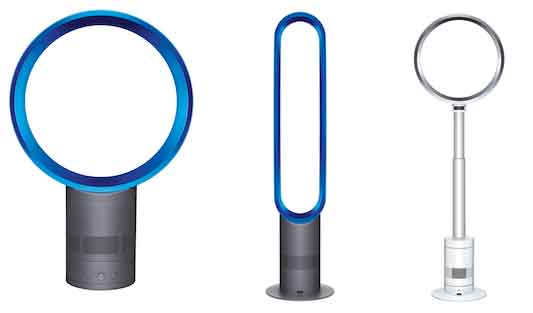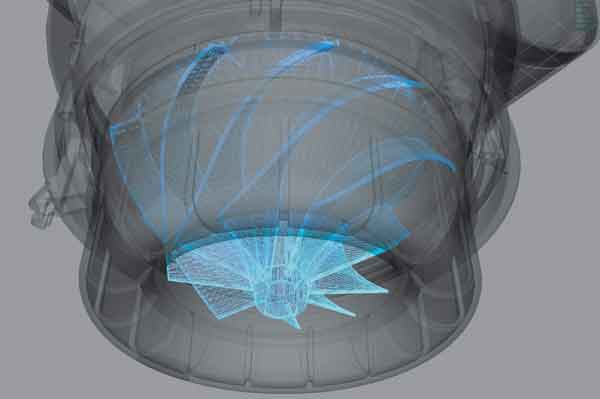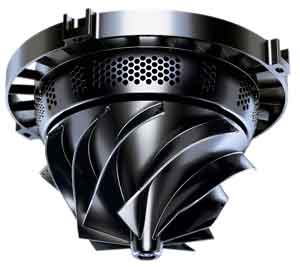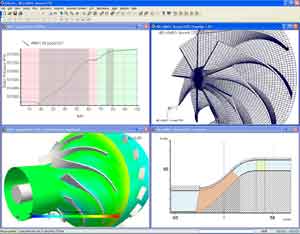July 12, 2011
By DE Editors
New ideas are the lifeblood of Dyson Ltd. Each year, the company reinvests a large amount of its profits into new idea generation at Dyson’s Research, Design and Development (RDD) Centre in Wiltshire, England. Located on the edge of Malmesbury, the RDD Centre is home to about 350 engineers—all thinking, testing, breaking and questioning.

From left are the Dyson Air Mutiplier fan range, AM01 Desk Fan, AM02 Tower Fan and AM03 Pedestal Fan.
The result is a series of everyday products that have been redesigned from the ground up to offer improved performance: the bagless vacuum cleaner, hand dryers using Airblade technology, and now, the bladeless fan.
If a bladeless fan sounds counter-intuitive, it is. But that’s Dyson. This is no ordinary engineering company; rather, it’s one that offers a proactive attitude to design, thinking outside conventional frameworks, and demonstrating a willingness to invest in the latest technologies that can help the company reach its goals in the most effective and efficient manner.
Air Multiplier Technology
Electric fans haven’t really changed since they were invented in 1882. Different materials, new buttons, and the addition of grilles, but still the same problem: The blades chop the air before it hits you. That’s why they cause unpleasant buffeting. Take the blades out, and the buffeting stops. But how can a fan work without blades?
Dyson engineers started with pressurized air, forcing it through narrow apertures to create jets. But they needed it to be more powerful to work in a fan. The breakthrough came when they noticed that accelerating air over a ramp amplified it by up to 20 times, drawing in surrounding air through processes known as inducement and entertainment.

Impeller integrated in the motor bucket.
That was the concept; now for the design. Today’s design process has to be far more efficient than that of yesteryear. When a young James Dyson became frustrated with his rapidly clogging conventional vacuum cleaner in 1979, he resolved to come up with a better design. However, it took him five years and 5,127 prototypes to perfect his bagless vacuum cleaner technology.
Today, things are different. Time-to-market is vital, and the period from concept to prototype is being squeezed continuously. The trick, of course, is not to hamper creative flair in the process. After all, it’s difficult to rush the best ideas.
One of the major challenges with the Dyson Air Multiplier bladeless fan was the problem of air intake. The motor had to suck in more than 20 liters of air per second to generate a powerful enough jet. It became clear that a 3D impeller was required—in effect, to provide the “engine” for AM01.
Having enjoyed considerable success using turbomachinery design and development software from Concepts NREC on projects such as a new turbine head to drive the brushes on a small, cylindrical vacuum cleaner for the Japanese market, and the DDM (Dyson Digital Motor) V2 for Dyson’s range of handheld vacuum cleaners, there was no doubting the optimum solution for the 3D impeller.
Software Solution
 Partial view of the AM01’s motor bucket, showing an unshrouded impeller, vaneless diffuser and vaned diffuser. |
Developed at Concepts NREC, the Agile Engineering Design System is currently the only commercially available turbomachinery design system that encompasses and integrates the complete engineering process through a complementary suite of tools and programs for CAE and CAM. Integrated elements of the system include preliminary design and detailed design, plus sophisticated analyses such as rapid computational fluid dynamics (CFD) and finite element analysis (FEA). The system also offers best-in-class, specialist five-axis machining software, automated optimization, and a smooth transfer of data to CAD packages.
Although AM01 was released to the retail market in 2009, design work on the 3D impeller began three years before under the tutorship of RDD Manager Frederic Nicolas.
“The challenge was to minimize acoustic emissions and make the quietest fan ever, which is why the rotational speeds are low, not high,” he explains.
How is a quiet fan achieved? There are two primary considerations: speed and flow rate. The speed is determined by the specification of the motor, but flow rate results from a combination of engineered products.
“We had to consider carefully the pressure required to overcome the resistance of the main aperture, and then choose the most suitable impeller technology,” says Michal Nurzynski, senior RDD engineer. “There are basically three types of impeller: radial (centrifugal), axial and mixed-flow. However, using Concepts NREC’s FANPAL application, it was clear that a mixed-flow solution would give us the best performance.
Design Wizard
FANPAL preliminary design CAE software uses a meanline approach to design axial, radial and mixed-flow fans, both for single and for multiple stages. Users deploy a Design Wizard to design the stage, analyze the performance, refine parameters with data reduction, and simulate the machine according to several performance models.
Various fundamental fluid dynamic aspects of fan performance can be modeled using FANPAL, such as disk friction, exit mixing, stator diffusion/losses, volutes, stall and thrust. FANPAL also offers direct integration with Concepts NREC’s AxCent CAE software for detailed blade design and fluid dynamic analysis.
“We used AxCent extensively to undertake iteration after iteration, detailing small changes in blade length and shape, before running the software’s real-time interactive flow analysis through streamline curvature to assess performance,” Nurzynski says.
AxCent has been developed to handle even the most complex blade geometry. Its many design features include:
- blade stacking of 2D cross sections;
- blade re-staggering around an arbitrary axis;
- bowed blades defined by hub-to-shroud bow profiles;
- bowed or sculpted elements with arbitrary number of mid-span sections;
- variable tip clearance on either end of the blade;
- flow cuts and radial trims;
- swept leading/trailing edges;
- multiple, offset and independent splitter blades; and
- irregular blade/splitter configurations for noise reduction.
“Using AxCent, we spotted that the acoustic performance of the blade was closely linked to blade shape, and we started designing to optimize flow conditions with blades unevenly spaced and blade angles developed to minimize end losses,” Nurzynski says.
The end result is an impeller featuring nine asymmetrically aligned fins, with rows of tiny peripheral holes to reduce the friction caused by colliding high and low air pressure. Birds of prey balance air pressure around their wings in a similar way.
Simulation Options
The preferred manufacturing method for all of Dyson’s plastic parts is injection molding. However, because tools for the injection molding process can be expensive and take weeks to manufacture, a suitable rapid prototyping method had to be identified. Dyson has both laser sintering and 3D printing technologies on site at Malmesbury, but with build times in days and hours rather than minutes, it is neither practical nor cost-effective to build a physical prototype for each impeller design.
 The AM01 impeller, as designed in AxCent. |
To optimize a new product designed for mass consumer markets, engineers require the ability to quickly evaluate hundreds of design candidates. This is where Concepts NREC’s CAE software scores heavily.
Simulating air flow using AxCent without the need for a physical prototype is of huge commercial advantage to companies such as Dyson. Being able to visualize flow throughout the impeller helped the RDD team gain an intuitive understanding of the design, leading to rapid improvements. Physical prototyping was only used to validate the final design, and the results correlated well with the simulation analysis.
“We don’t just accept that Concepts NREC software is the best tool for the job, it has to compete with other technologies,” states Nicolas. “However, on AM01 and previous projects, we have demonstrated time and time again that we can make the first prototype on specification in terms of performance using Concepts NREC software. The software more than passes the exam in this respect.”
The RDD team at Dyson has, in fact, tried using alternative software for the same function, but found it more general-purpose and less time-efficient.
“Concepts NREC is front-end specific for turbomachinery design,” says RDD Engineer Lukasz Kowalczyk. “We can model impeller features and diffuser vanes all parametrically set to a design point. Because of this, changes are straightforward and efficient to implement. For instance, if we need to change flow rate or pressure, the software can output how the whole system will react to these changes—it’s a very responsive software package and a perfect niche product.”
It’s been six years since the first seat of Concepts NREC software was installed at Malmesbury, but its success has been such that Dyson now has three seats of FANPAL and three seats of AxCent.
“Every time we release a product, we are already working on its replacement,” Nicolas concludes. “For the Dyson Air Multiplier fans, the next challenge will be to reduce the acoustic output even further, to little more than a ‘breathing’ noise.”
Info
Concepts NREC
Subscribe to our FREE magazine, FREE email newsletters or both!
About the Author
DE’s editors contribute news and new product announcements to Digital Engineering.
Press releases may be sent to them via [email protected].






